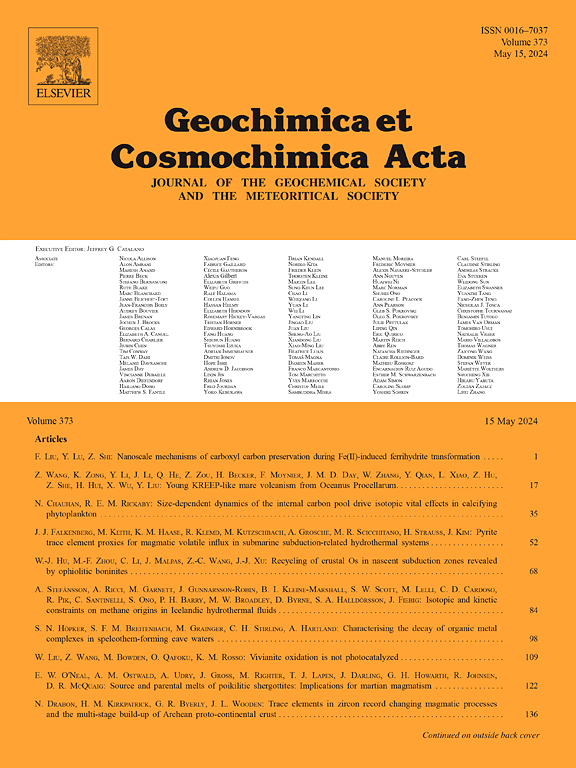Drivers of inorganic and organic carbon removal in aged oceanic crust
IF 4.5
1区 地球科学
Q1 GEOCHEMISTRY & GEOPHYSICS
引用次数: 0
Abstract
Large volumes of fluid flow through aged oceanic crust. Given the scale of this water flux, the exchange of organic and inorganic carbon that it mediates between the crust and deep ocean can be significant. However, off-axis carbon fluxes in older oceanic crust are still poorly constrained because access to low-temperature fluids from this environment is limited. At North Pond, a sedimented depression located on 8-million-year-old crust on the flank of the Mid-Atlantic Ridge, circulating crustal fluids are accessible through drilled borehole observatories. Here, fluids are cool (≤ 20 °C), oxygenated and bear strong geochemical similarities to bottom seawater. In this study, we report the concentrations and isotopic composition of dissolved organic and inorganic carbon from crustal fluids that were sampled six years after the installation of borehole observatories. These which better represent the fluid geochemistry prior to drilling and perturbation than earlier studies. Radiocarbon-based signatures within carbon reservoirs support divergent shallow and deep fluid pathways within the crust. We also report a net loss of both dissolved inorganic carbon (DIC) and dissolved organic carbon (DOC) from the fluid during isolation in the crust. The removal of DOC is isotopically selective and consistent with microbe-mediated DOC oxidation. The loss of DIC is consistent with carbonate precipitation, although geochemical signatures of DIC addition to the fluids from DOC oxidation and basalt weathering are also evident. Extrapolated to global fluxes, systems like North Pond could be responsible for a net loss of ∼ 1011 mol C yr−1 of DIC and ∼ 1011 mol C yr−1 of DOC during the circulation of fluids through oceanic crust at low temperatures.
求助全文
约1分钟内获得全文
求助全文
来源期刊

Geochimica et Cosmochimica Acta
地学-地球化学与地球物理
CiteScore
9.60
自引率
14.00%
发文量
437
审稿时长
6 months
期刊介绍:
Geochimica et Cosmochimica Acta publishes research papers in a wide range of subjects in terrestrial geochemistry, meteoritics, and planetary geochemistry. The scope of the journal includes:
1). Physical chemistry of gases, aqueous solutions, glasses, and crystalline solids
2). Igneous and metamorphic petrology
3). Chemical processes in the atmosphere, hydrosphere, biosphere, and lithosphere of the Earth
4). Organic geochemistry
5). Isotope geochemistry
6). Meteoritics and meteorite impacts
7). Lunar science; and
8). Planetary geochemistry.
 求助内容:
求助内容: 应助结果提醒方式:
应助结果提醒方式:


